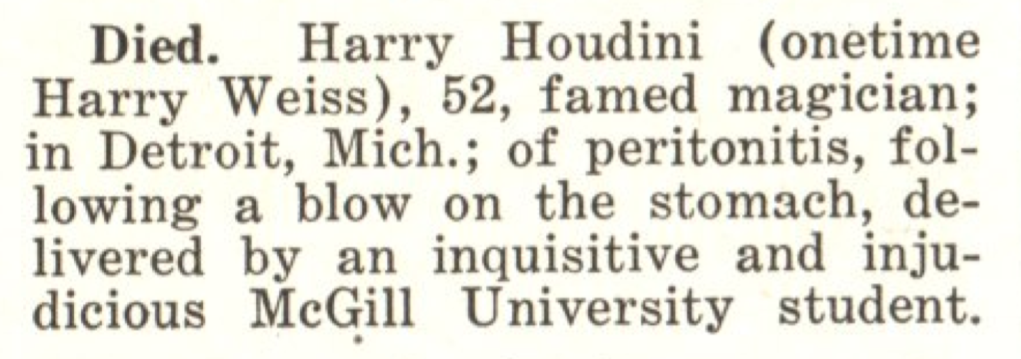
In the cutthroat world of magicians and mediums, Harry Houdini made enemies.
He had racked up so much ill will by the time of his mysterious death, in fact, that some people suspected he had been poisoned by psychics whose claims he regularly debunked.
The cause of Houdini’s death — on this day, Halloween, in 1926 — was officially a combination of appendicitis and peritonitis, an infection of the abdominal lining. But its onset was swift and surprising in the otherwise healthy 52-year-old, known for superhuman strength and the ability to escape every tight spot he had ever found himself in — including being buried alive, one of four “close-ups with death” of his career, according to a New York Times story.
The Times reported on the bizarre string of events that led up to the fatal infection, including a barrage of gut punches from a college student who wanted to test the strength of Houdini’s stomach muscles. Although a doctor told him that his appendix had likely ruptured, Houdini performed in a scheduled show rather than undergo immediate surgery, his obituary reveals.
A theory soon emerged that his death was no accident, however, and the rumor stuck. As recently as 2008, Houdini’s grandnephew sought permission to exhume his body and test for poison, noting that the outspoken magician had given many people motive for murder.
In addition to being a masterful escape artist who broke free from handcuffs and straightjackets, prisons and padded cells, a leather mail pouch and a giant milk can filled with water, Houdini was an acerbic critic of clairvoyants he believed were defrauding the public. He denounced famed mediums as a member of the Scientific American Committee on Psychic Phenomena in 1924, as TIME reported, and went on to recreate their tricks before his own audiences later.
In 1926, he testified before Congress in favor of a bill to regulate mediums and fortune-tellers, toward whom he showed both skepticism and contempt. It was easy to see why they might want him out of the way.
Notwithstanding his suspicion of séances, he hadn’t ruled out the possibility of communicating with spirits. He and his wife agreed that when one of them died, they’d each attempt to get in touch with the other from whichever world they found themselves in.
Wilhelmina Houdini held up her end of the bargain: For more than three years after his death, she attempted to make contact. And while a number of so-called spiritualists told her they’d had gotten messages from her husband, it was easy to tell they were fakes, according to a 1930 dispatch in TIME: “She and Houdini prearranged a code, in which no medium has yet brought word from him.”
Finally she gave up, taking his silence as a sign that the spirit world does not exist — or at least, it doesn’t talk. Houdini’s psychic foes, on the other hand, took it as a sign that he continued to spite them from beyond the grave.
According to TIME: “Spiritualists retorted that it proved nothing. Some even charged that Houdini’s spirit is being stubborn.”
Read more about Mrs. Houdini’s conclusion, here in TIME’s archives: Houdini, Doyle
Photos: Houdini Being Houdini
More Must-Reads from TIME
- Donald Trump Is TIME's 2024 Person of the Year
- Why We Chose Trump as Person of the Year
- Is Intermittent Fasting Good or Bad for You?
- The 100 Must-Read Books of 2024
- The 20 Best Christmas TV Episodes
- Column: If Optimism Feels Ridiculous Now, Try Hope
- The Future of Climate Action Is Trade Policy
- Merle Bombardieri Is Helping People Make the Baby Decision
Contact us at letters@time.com